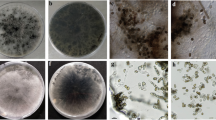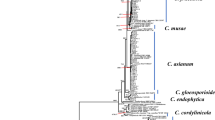Abstract
Mango (Mangifera indica) is a major tropical fruit species cultivated in Brazil. The objective of this study was to identify species of Lasiodiplodia associated with dieback and stem-end rot of mango in the semi-arid region of Northeastern Brazil, and compare the species in relation to mycelial growth, pathogenicity and virulence. A total of 120 isolates of Lasiodiplodia were used and identifications were made using a combination of morphology and phylogenetic analysis based on partial translation elongation factor 1-α sequence (EF1-α) and internal transcribed spacers (ITS). The following species were identified: Lasiodiplodia crassispora, L. egyptiacae, L. hormozganensis, L. iraniensis, L. pseudotheobromae, L. theobromae and Lasiodiplodia sp.. Lasiodiplodia theobromae was the most frequently isolated species, which represented 41 % of all the isolates. Only this species had been previously reported on mango in Brazil, while the other species represent the first report associated with mango tree diseases in this country. Lasiodiplodia crassispora is reported for the first time associated with mango diseases worldwide. There were significant differences in mycelial growth rates among the Lasiodiplodia species and also in the optimum temperature for growth. All species of Lasiodiplodia were pathogenic on mango fruit. There were significant differences in virulence among the species, wherein L. hormozganensis and Lasiodiplodia sp.were the most virulent, while the least virulent were L. iraniensis, L. pseudotheobromae, L. crassispora and L. egyptiacae.



Similar content being viewed by others
References
Abdollahzadeh J, Javadi A, Mohammadi-Goltapeh E, Zare R, Phillips AJL (2010) Phylogeny and morphology of four new species of Lasiodiplodia from Iran. Persoonia 25:1–10
Agrianual (2012) Anuário da agricultura brasileira. Informa Economics/FNP South America, São Paulo, 482 p
Al Adawi AO, Deadman ML, Al Rawahi AK, Khan AJ, Al Maqbali YM (2003) Diplodia theobromae associated with sudden decline of mango in the Sultanate of Oman. Plant Pathol 52:419
Alves A, Crous PW, Correia A, Phillips AJL (2008) Morphological and molecular data reveal cryptic speciation in Lasiodiplodia theobromae. Fungal Divers 28:1–13
Assis JS (2004) Cultivo da mangueira: Colheita e pós-colheita. Embrapa Semi-Árido, Petrolina. http://sistemasdeproducao.cnptia.embrapa.br/FontesHTML/Manga/CultivodaMangueira/colheita.htmAccessed 23 June 2012
Batista AC (1947) Mal do Recife, grave doença da mangueira. Escola Superior de Agricultura de Pernambuco, Recife, 5 p
Begoude BAD, Slippers B, Wingfield MJ, Roux J (2010) Botryosphaeriaceae associated with Terminalia catappa in Cameroon, South Africa and Madagascar. Mycol Prog 9:101–123
Burgess TI, Barber PA, Mohali S, Pegg G, de Beer W, Wingfield MJ (2006) Three new Lasiodiplodia spp. from the tropics, recognized based on DNA comparisons and morphology. Mycologia 98:423–435
Correia KC, Câmara MPS, Barbosa MAG, Sales R Jr, Agustí-Brisach C, Gramaje D, García-Jiménez J, Abad-Campos P, Armengol J, Michereff SJ (2012) Fungal species associated with trunk diseases of table grapes in Northeastern Brazil. Phytopathol Mediterr 51:427
Costa VSO, Michereff SJ, Martins RB, Gava CAT, Mizubuti ESG, Camara MPS (2010) Species of Botryosphaeriaceae associated on mango in Brazil. Eur J Plant Pathol 127:509–519
Crous PW, Slippers B, Wingfield MJ, Rheeder J, Marasas WFO, Philips AJL, Alves A, Burgess T, Barber P, Groenewald JZ (2006) Phylogenetic lineages in the Botryosphaeriaceae. Stud Mycol 55:235–253
Damm U, Crous PW, Fourie PH (2007) Botryosphaeriaceae as potential pathogens of Prunus in South Africa, with descriptions of Diplodia africana and Lasiodiplodia plurivora sp. nov. Mycologia 99:664–680
Denman S, Crous PW, Taylor JE, Kang JC, Pasco I, Wingfield MJ (2000) An overview of the taxonomic history of Botryosphaeria, and a re-evaluation of its anamorphs based on morphology and ITS rDNA phylogeny. Stud Mycol 45:129–140
Farris JS, Kallersjo M, Kluge AG, Bult C (1995) Testing significance of incongruence. Cladistics 10:315–319
Freire FCO, Cardoso JE, Viana FMP (2003) Doenças de fruteiras tropicais de interesse agroindustrial. Embrapa Informação Tecnológica, Brasília, 687 p
Hillis DM, Bull JJ (1993) An empirical test of bootstrap** as a method for assessing confidence in phylogenetic analysis. Syst Biol 42:182–192
Huelsenbeck JP, Bull JJ, Cunningham CV (1996) Combining data in phylogenetic analysis. Trends Ecol Evol 11:152–158
Ismail AM, Cirvilleri G, Polizzi G, Crous PW, Groenewald JZ, Lombard L (2012) Lasiodiplodia species associated with dieback disease of mango (Mangifera indica) in Egypt. Australas Plant Pathol 41:649–660
Jacobs R (2002) Characterization of Botryosphaeria species from mango in South Africa. Thesis, University of Pretoria. 162 p
Javier-Alva J, Gramaje D, Alvarez LA, Armengol J (2009) First report of Neofusicoccum parvum associated with dieback of mango trees in Peru. Plant Dis 93:426
Johnson GI (1992) Biology and control of stem end rot pathogens of mango. Thesis, University of Queensland. 530 p
Khanzada MA, Lodhi AM, Shahzad S (2004) Pathogenicity of Lasiodiplodia theobromae and Fusarium solani on mango. Pak J Bot 36:181–189
Liu JK, Phookamsak R, Mingkhuan M, Wikee S, Li YM, Ariyawansha H, Boonmee S, Chomnunti P, Dai DQ, Bhat JD, Romero AI, Zhuang WY, Monkai J, Gareth Jones EB, Chukeatirote E, Ko Ko TW, Zhao YC, Wang Y, Hyde KD (2012) Towards a natural classification of Botryosphaeriales. Fungal Divers 57:149–210
Marques MW, Lima NB, Michereff SJ, Câmara MPS, Souza CRB (2012) First report of mango dieback caused by Pseudofusicoccum stromaticum in Brazil. Plant Dis 96:144–145
Page RD (1996) TreeView: an application to display phylogenetic trees on personal computers. Comput Appl Biosci 12:357–358
Pavlic D, Slippers B, Coutinho TA, Gryzenhout M, Wingfield MJ (2004) Lasiodiplodia gonubiensis sp. nov., a new Botryosphaeria anamorph from native Syzygium cordatum in South Africa. Stud Mycol 50:313–322
Pavlic D, Wingfield MJ, Barber P, Slippers B, Harder GES, Burgess TI (2008) Seven new species of the Botryosphaeriaceae from baobab and other native trees in Western Australia. Mycologia 100:851–866
Perez CA, Wingfield MJ, Slippers B, Altier NA, Blanchette RA (2010) Endophytic and canker-associated Botryosphaeriaceae occurring on non-native Eucalyptus and native Myrtaceae trees in Uruguay. Fungal Divers 41:53–69
Phillips AJL (2006) The Botryosphaeria site. http://www.crem.fct.unl.pt/botryosphaeria_site. Accessed 10 June 2010
Phillips AJL, Alves A, Correia A, Luque J (2005) Two new species of Botryosphaeria with brown, 1-septate ascospores and Dothiorella anamorphs. Mycologia 97:513–529
Phillips AJL, Alves A, Pennycook SR, Johnston PR, Ramaley A, Akulov A, Crous PW (2008) Resolving the phylogenetic and taxonomic status of dark-spored teleomorph genera in the Botryosphaeriaceae. Persoonia 21:29–55
Ploetz RC, Benscher D, Vázquez A, Colls A, Nagel J, Schaffer B (1996) A re-examination of mango decline in Florida. Plant Dis 80:664–668
Punithalingam E (1976) Botryodiplodia theobromae. CMI Descriptions of pathogenic fungi and bacteria, No. 519. Commonwealth Mycological Institute, Kew, 2 p
Punithalingam E (1980) Plant diseases attributed to Botryodiplodia theobromae Pat. Cramer, Vaduz, 123 p
Rannala B, Yang Z (1996) Probability distribution of molecular evolutionary trees: a new method of phylogenetic inference. J Mol Evol 43:304–311
Rodriguez F, Oliver JF, Marin A, Medina JR (1990) The general stochastic model of nucleotide substitutions. J Mol Evol 142:485–501
Ronquist F, Huelsenbeck JP (2003) MrBayes3: Bayesian phylogenetic inference under mixed models. Bioinformatics 19:1572–1574
Sakalidis ML, Ray JD, Lanoiselet V, Hardy GESJ, Burgess TI (2011a) Pathogenic Botryosphaeriaceae associated with Mangifera indica in the Kimberley Region of Western Australia. Eur J Plant Pathol 130:379–391
Sakalidis ML, Hardy GESJ, Burgess TI (2011b) Endophytes as potential pathogens of the baobab species Adansonia gregorii: a focus on the Botryosphaeriaceae. Fungal Ecol 4:1–14
Slippers B, Crous PW, Denman S, Coutinho TA, Wingfield BD, Wingfield MJ (2004) Combined multiple gene genealogies and phenotypic characters differentiate several species previously identified as Botryosphaeria dothidea. Mycologia 96:83–101
Slippers B, Johnson GI, Crous PW, Coutinho TA, Wingfield B, Wingfield MJ (2005) Phylogenetic and morphological re-evaluation of the Botryosphaeria species causing diseases of Mangifera indica. Mycologia 97:99–110
Souza JS, Almeida CO, Araújo JLP, Cardoso CEL (2002) Aspectos socioeconômicos. In: Genú PJC, Pinto ACQ (eds) A cultura da mangueira. Embrapa Informação Tecnológica, Brasília, pp 19–29
Sutton BC (1980) The Coelomycetes: fungi imperfecti with pycnidia, acervuli and stromata. Commonwealth Mycological Institute, Kew, 696 p
Swofford DL (2003) PAUP: Phylogenetic analysis using parsimony (*and other methods) Version 4. Sinauer Associates, Sunderland
Tavares SCCH (2002) Epidemiologia e manejo integrado de Botryodiplodia theobromae - situação atual no Brasil e no mundo. Fitopatol Bras 27:46–52
Tavares SCCH, Menezes M, Choudhury MM (1991) Infecção da mangueira por Botryodiplodia theobromae Pat. na região semi-árida de Pernambuco. Rev Bras Frutic 13:163–166
Thompson JD, Gibson TJ, Plewniak F, Jeanmougin F, Higgins DG (1997) The ClustalX windows interface: flexible strategies for multiple sequence alignment aided by quality analysis tools. Nucleic Acids Res 25:4876–4882
Úrbez-Torres JR, Peduto F, Gubler WD (2010) First report of grapevine cankers caused by Lasiodiplodia crassispora and Neofusicoccum mediterraneum in California. Plant Dis 94:785
Úrbez-Torres JR, Peduto F, Striegler RK, Urrea-Romero KE, Rupe JC, Cartwright RD, Gubler WD (2012) Characterization of fungal pathogens associated with grapevine trunk diseases in Arkansas and Missouri. Fungal Divers 52:169–189
White TJ, Bruns T, Lee S, Taylor J (1990) Amplification and direct sequencing of fungal ribosomal RNA genes for phylogenetics. In: Innis MA, Gelfand DH, Sninsky JJ, White TJ (eds) PCR protocols, a guide to methods and applications. Academic, San Diego, pp 315–322
Young ND, Healey J (2003) GapCoder automates the use of indel characters in phylogenetic analysis. BMC Bioinforma 4:6, http://www.biomedcentral.com/content/pdf/1471-2105-4-6.pdf
Acknowledgments
We are grateful to Sequencing Platform LABCEN/CCB in the Universidade Federal de Pernambuco for use of its facilities. This work was financed by Conselho Nacional de Desenvolvimento Científico e Tecnológico (CNPq 141275/2009-0) and Coordenação de Aperfeiçoamento de Pessoal de Nível Superior (CAPES/BEX 0245/12-7). M. P. S. Câmara, Marcos A. Morais Junior and S. J. Michereff also acknowledge the CNPq research fellowship. A. J.L. Phillips thanks Fundação para a Ciência e a Tecnologia (Portugal) for financial support through grant PEst-OE/BIA/UI0457/2011
Author information
Authors and Affiliations
Corresponding author
Rights and permissions
About this article
Cite this article
Marques, M.W., Lima, N.B., de Morais, M.A. et al. Species of Lasiodiplodia associated with mango in Brazil. Fungal Diversity 61, 181–193 (2013). https://doi.org/10.1007/s13225-013-0231-z
Received:
Accepted:
Published:
Issue Date:
DOI: https://doi.org/10.1007/s13225-013-0231-z




